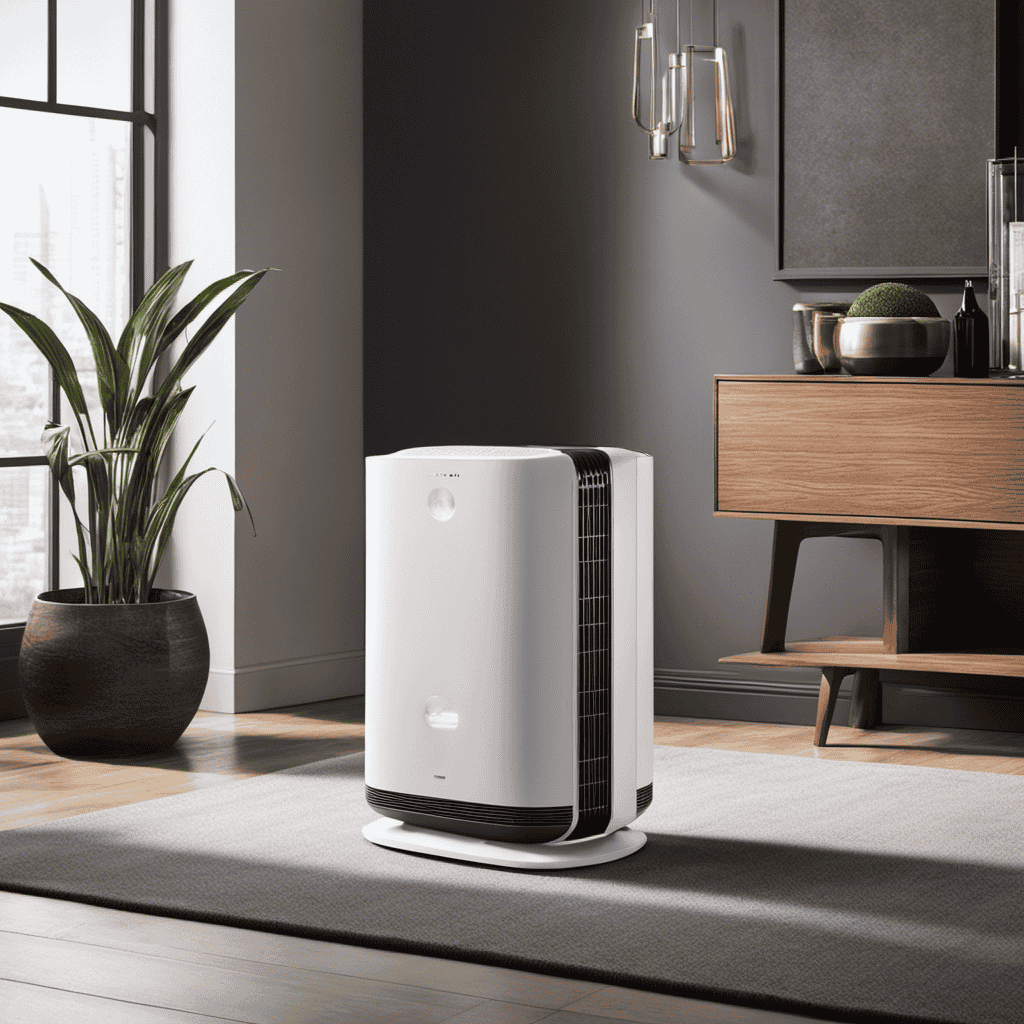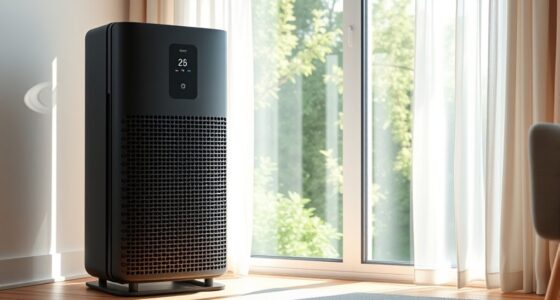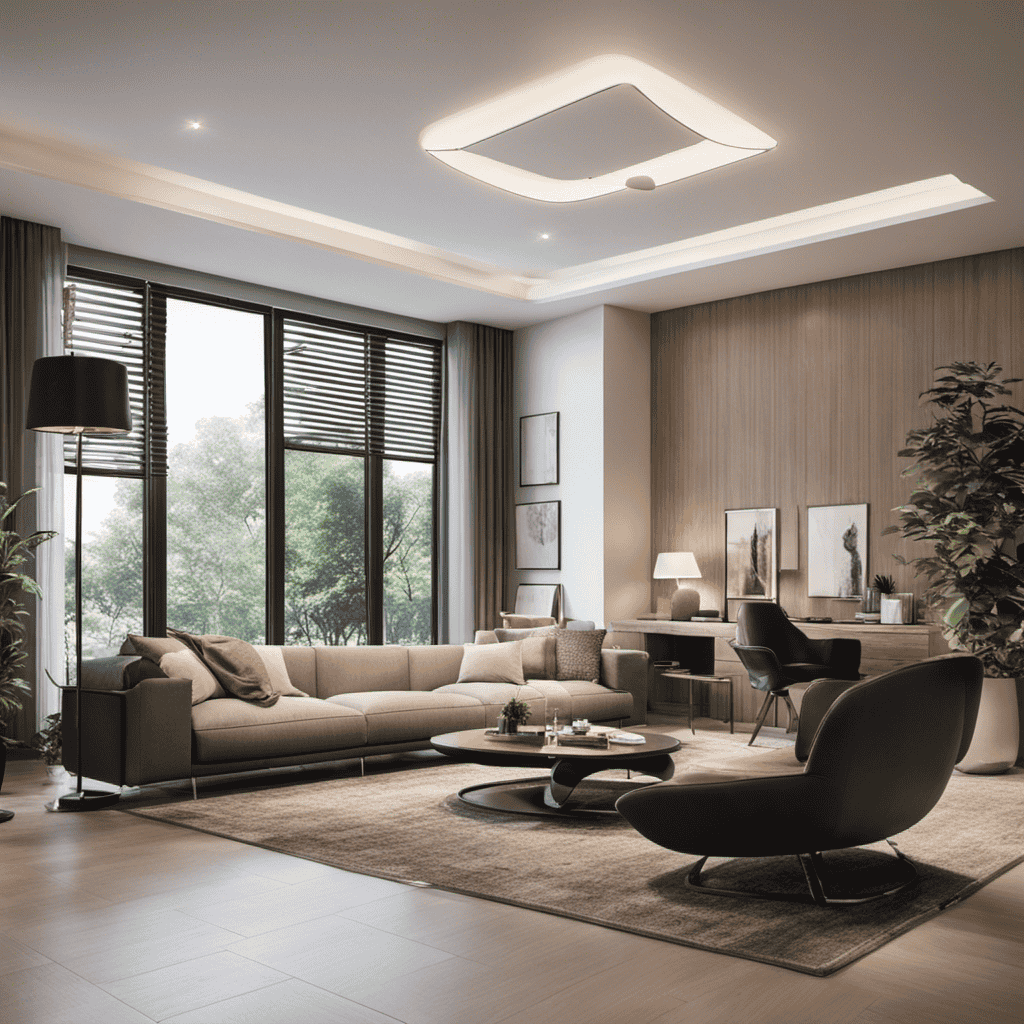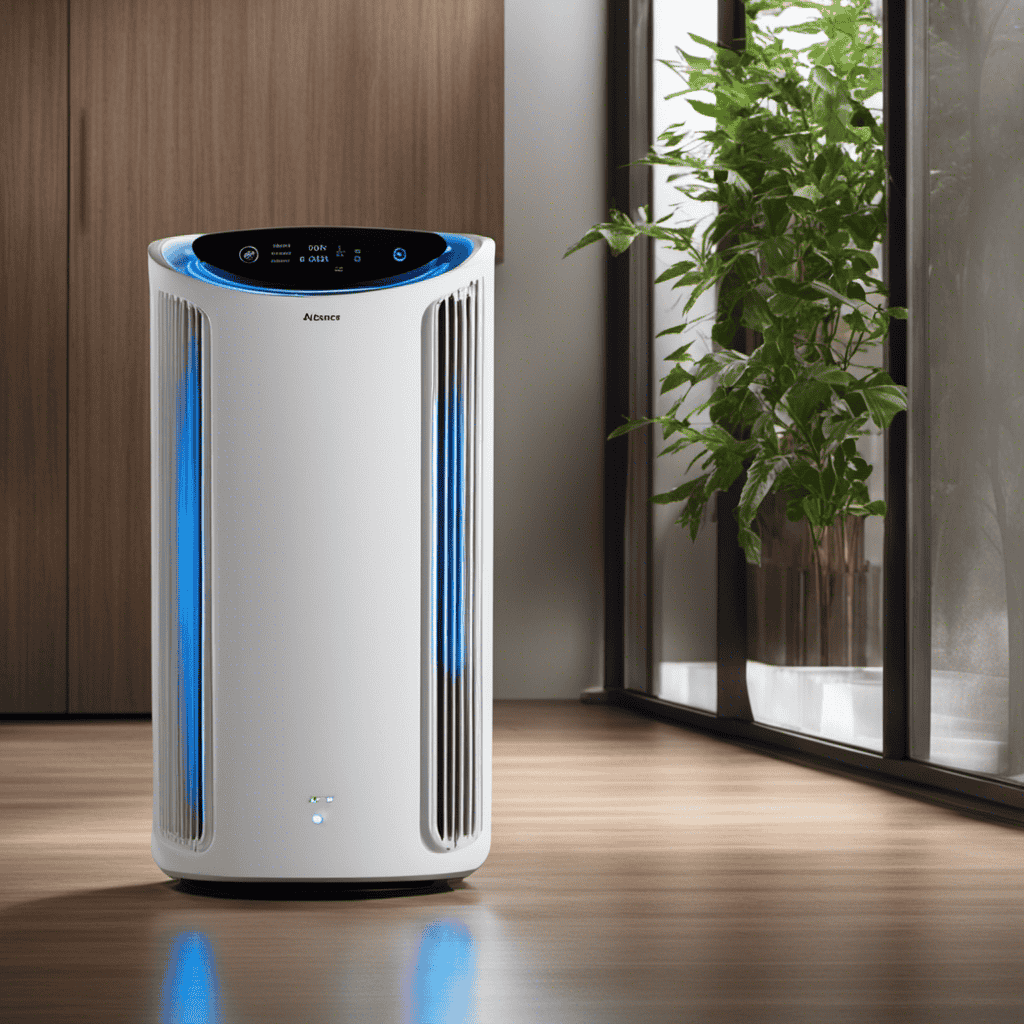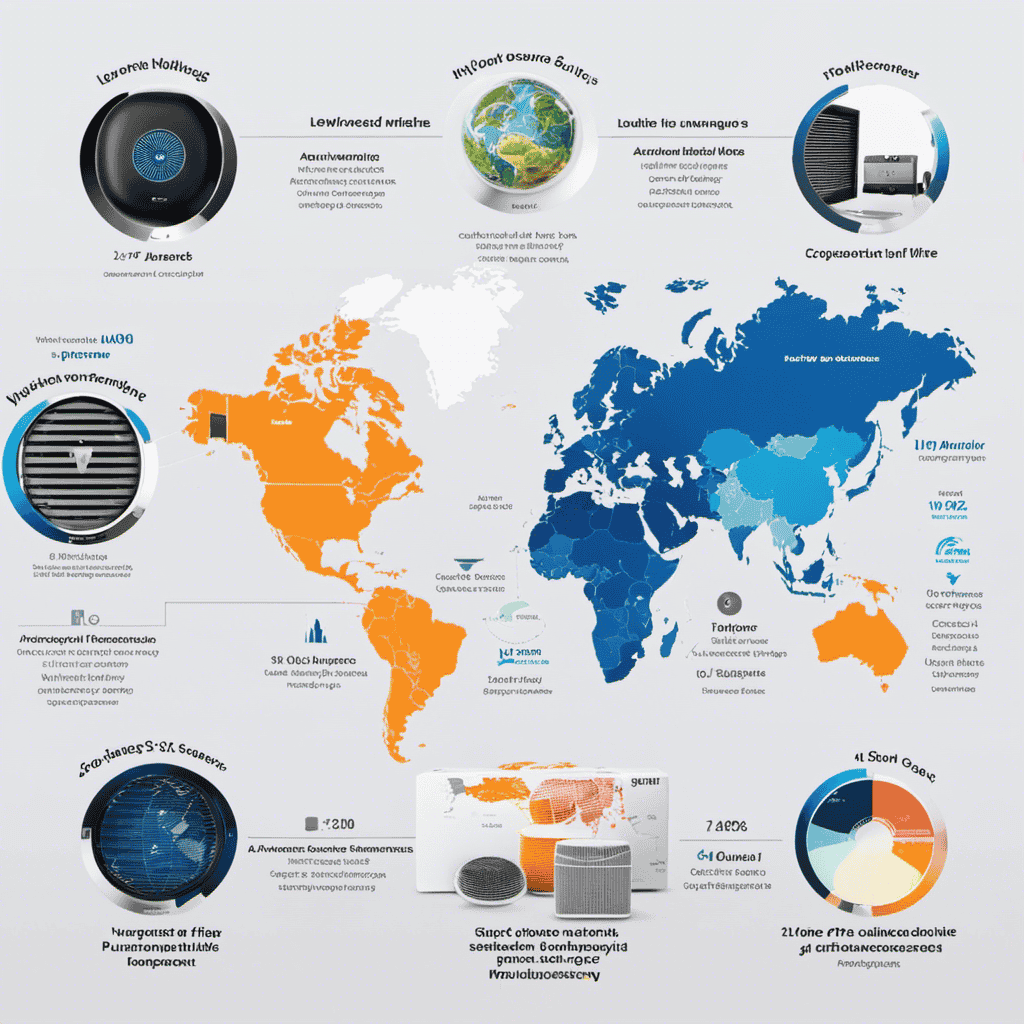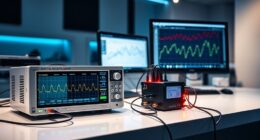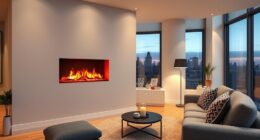As someone who values clean and healthy air, I frequently search for ways to enhance the air quality I breathe in.
One solution that has caught my attention is the room air purifier. Like a vigilant guardian, this device works tirelessly to eliminate pollutants from the air, creating a fresher and healthier environment.
In this article, we will delve into the various types of room air purifiers, how they work, and the key features to consider.
Join me on this exploration of the wonders of room air purifiers.
Key Takeaways
- Room air purifiers utilize a combination of filters, including HEPA filters and activated carbon filters, to remove harmful particles like dust, pollen, and smoke.
- Some models of room air purifiers also utilize UV-C light technology to trap and neutralize contaminants.
- Reputable brands like Honeywell, Dyson, Levoit, Blueair, and Coway offer a variety of models with different features to suit different room sizes and air quality needs.
- Using a room air purifier can improve air quality, enhance respiratory health, reduce the risk of respiratory infections, and create a cleaner and healthier environment.
Types of Room Air Purifiers
There are different types of room air purifiers available in the market. When it comes to choosing the right one for allergies, it is important to consider the pros and cons of different technologies.
One popular type is HEPA (High-Efficiency Particulate Air) filters, which are highly effective at removing airborne particles like dust, pollen, and pet dander. However, they may not be as effective against volatile organic compounds (VOCs) and odors.
Another option is activated carbon filters, which excel at removing odors and chemicals but may not be as efficient in capturing larger particles.
Additionally, there are air purifiers that use ionizers or ozone generators, which can effectively eliminate airborne particles but may produce ozone as a byproduct, which can be harmful in high concentrations.
Transitioning into the next section, understanding how these different technologies work is crucial in making an informed decision.
How Room Air Purifiers Work
One way these devices function is by filtering out harmful particles in the surrounding environment. Room air purifiers are designed to improve indoor air quality by removing pollutants such as dust, pollen, pet dander, mold spores, and smoke particles from the air. These devices typically use a combination of filters, including HEPA (High Efficiency Particulate Air) filters, activated carbon filters, and sometimes even UV-C light technology to trap and neutralize harmful contaminants.
Room air purifiers offer a range of benefits for individuals and families. They can help alleviate symptoms of allergies and asthma by reducing the presence of triggers in the air. Additionally, they can remove unpleasant odors, improve sleep quality, and create a more comfortable living environment.
When it comes to room air purifier brands, there are several reputable options available in the market. Some popular brands include Honeywell, Dyson, Levoit, Blueair, and Coway. These brands offer a variety of models with different features and filter technologies to suit individual needs and preferences.
| Brand | Features | Filter Technology |
|---|---|---|
| Honeywell | HEPA Filters | Activated Carbon Filters |
| Dyson | Air Multiplier | HEPA Filters |
| Levoit | Quiet Operation | HEPA Filters |
| Blueair | Smart Sensors | Electrostatic Filters |
| Coway | Eco Mode | HEPA Filters |
Overall, room air purifiers are an effective way to improve indoor air quality and enjoy the benefits of cleaner, healthier air.
Key Features to Consider in a Room Air Purifier
When considering a room air purifier, two key factors to examine are the filter types and the suitability for the room size.
Comparing filter types is crucial as different filters target specific pollutants, such as dust, pollen, or pet dander.
Additionally, understanding the room size suitability is essential to ensure the air purifier can effectively clean the air in the given space.
Filter Types Comparison
If you’re comparing filter types for a room air purifier, it’s essential to consider factors like effectiveness and maintenance requirements. There are several options available in the market, each with its own benefits and drawbacks.
Here are the two main types of filters commonly used in room air purifiers:
-
HEPA Filters:
-
Highly effective at removing particles as small as 0.3 microns.
-
Requires regular replacement to maintain optimal performance.
-
Activated Carbon Filters:
-
Excellent at removing odors, gases, and volatile organic compounds (VOCs).
-
Needs periodic replacement to ensure continued effectiveness.
When choosing a filter, it’s important to consider the specific needs of your environment and the air quality concerns you have. Additionally, it’s worth researching reputable room air purifier brands known for their quality and customer satisfaction.
Room Size Suitability
To determine the suitability of a room size, you should consider factors such as the square footage and the recommended coverage area of the filter. Room air purifiers come in various sizes, each designed to effectively clean the air in different sized rooms. The size of the room plays a crucial role in determining the effectiveness of the air purifier. Using an air purifier that is too small for a room will result in inefficient purification, while using one that is too large may be unnecessary and costly. To help you choose the right size for your room, here is a table that provides a general guideline based on square footage:
| Room Size | Recommended Air Purifier Size |
|---|---|
| Small | Up to 300 square feet |
| Medium | 301-600 square feet |
| Large | 601-900 square feet |
Considering the size of your room is essential to ensure the effectiveness of your room air purifier. Now, let’s explore the benefits of using a room air purifier.
Benefits of Using a Room Air Purifier
You can experience several benefits by using a room air purifier.
-
Improves air quality:
-
Removes dust, pollen, pet dander, and other allergens from the air.
-
Reduces the presence of harmful airborne particles, such as bacteria and viruses.
-
Enhances respiratory health:
-
Helps alleviate symptoms of allergies, asthma, and other respiratory conditions.
-
Reduces the risk of respiratory infections by eliminating pathogens from the air.
Using an air purifier can provide numerous advantages, such as improving overall air quality and promoting better respiratory health. By removing allergens and harmful particles from the air, air purifiers create a cleaner and healthier environment. This is particularly beneficial for individuals with allergies, asthma, or other respiratory conditions, as it helps alleviate symptoms and reduces the risk of respiratory infections.
With these benefits in mind, it is important to understand the common indoor air pollutants that air purifiers can effectively remove.
[Transition sentence: In the next section, we will explore the common indoor air pollutants that air purifiers are capable of removing.]Common Indoor Air Pollutants Removed by Air Purifiers
When it comes to improving indoor air quality, one crucial aspect to consider is the removal of harmful airborne particles. These particles can include dust, pollen, pet dander, and even mold spores. All of these particles can have detrimental effects on our health when inhaled.
Harmful Airborne Particles
If you’re concerned about harmful airborne particles, an air purifier can help filter them out of the room. Air pollution is a major concern when it comes to respiratory health, as it can contain various harmful particles that can be detrimental to our lungs. These particles can come from sources such as vehicle emissions, industrial processes, and even household cleaning products.
When considering an air purifier, it’s important to understand the types of harmful airborne particles that it can help remove. Here are two key subtopics about harmful airborne particles:
-
Particulate Matter (PM):
-
PM2.5: Fine particles that can penetrate deep into the respiratory system.
-
PM10: Coarser particles that can irritate the nose, throat, and lungs.
-
Volatile Organic Compounds (VOCs):
-
Chemicals emitted from products like paints, furniture, and cleaning supplies.
-
Can cause respiratory irritation and long-term health effects.
Improved Indoor Air Quality
Improved indoor air quality can have a positive impact on our respiratory health and overall well-being. One effective way to achieve this is by using a room air purifier. These devices work by filtering out harmful airborne particles, such as dust, pollen, pet dander, and mold spores. By removing these pollutants from the air we breathe, room air purifiers can significantly improve the quality of the air in our homes or offices. This, in turn, can reduce the risk of respiratory problems, allergies, and asthma attacks. Additionally, having cleaner air can also lead to better sleep, increased productivity, and a general sense of well-being. Investing in a room air purifier is a worthwhile step towards creating a healthier indoor environment.
| Benefits of Room Air Purifiers | ||
|---|---|---|
| Removes harmful airborne particles | Reduces respiratory problems | Improves sleep quality |
| Filters out dust, pollen, and pet dander | Reduces risk of allergies and asthma attacks | Increases productivity |
| Removes mold spores and other pollutants | Enhances overall well-being | Creates a healthier indoor environment |
Factors to Consider When Choosing a Room Air Purifier
To choose a room air purifier, you should consider factors such as the size of the room and your specific air quality needs. When it comes to room air purifier brands, there are several options available in the market.
Some popular brands include Honeywell, Dyson, Coway, and Blueair. Prices for room air purifiers can vary depending on the brand, features, and filtration technology. It is important to set a budget and compare prices to find a purifier that fits your needs and budget.
Additionally, you need to consider the Clean Air Delivery Rate (CADR), which indicates how efficiently the purifier can remove pollutants from the air. Other factors to consider include the type of filtration system, noise level, energy efficiency, and additional features like air quality sensors or smart connectivity.
Proper Placement and Maintenance of Room Air Purifiers
When properly placed and maintained, room air purifiers can effectively remove pollutants from the air, improving indoor air quality. To ensure optimal performance, it is important to follow a room air purifier maintenance checklist and troubleshoot common issues that may arise.
| Maintenance Checklist | Troubleshooting Issues |
|---|---|
| Clean or replace filters regularly | Strange odors or noises |
| Vacuum the exterior regularly | Reduced airflow |
| Check and clean the fan blades | Malfunctioning controls |
Regular maintenance of your room air purifier is crucial to ensure its efficiency. Cleaning or replacing filters regularly helps to remove accumulated dust and allergens. Vacuuming the exterior prevents the buildup of dirt and debris, while cleaning the fan blades ensures proper airflow.
In the case of troubleshooting, if you encounter strange odors or noises, it is recommended to check for any loose parts or damaged filters. Reduced airflow may be due to a clogged filter or a blocked intake grille. Malfunctioning controls can be resolved by checking the power source and ensuring proper settings.
Understanding CADR and ACH in Room Air Purifiers
Understanding CADR (Clean Air Delivery Rate) and ACH (Air Changes per Hour) can help you choose the most effective air purifier for your needs.
CADR measures the purifier’s ability to remove specific pollutants from the air, such as pollen, dust, and smoke. It is an important factor in determining the purifier’s efficiency in reducing allergies. CADR ratings are given for three types of pollutants: tobacco smoke, dust, and pollen. Higher CADR ratings indicate faster and more effective purification. When comparing air purifiers, look for models with CADR ratings that match your specific needs.
ACH measures how many times the purifier can exchange the air in a room in an hour. A higher ACH means more frequent air changes, which can further reduce airborne allergens. To effectively reduce allergies, aim for an ACH of 4 or higher in the room where the air purifier is placed. Factors such as room size and the purifier’s airflow capacity affect the ACH.
Understanding the CADR vs ACH comparison and the importance of air purifiers in reducing allergies can guide you in making an informed decision to improve your indoor air quality.
Noise Levels and Energy Efficiency of Room Air Purifiers
When considering room air purifiers, it’s important to assess their noise levels and effectiveness.
No one wants a device that’s too loud to be tolerable, but it’s also crucial that the air purifier effectively removes pollutants from the air.
Additionally, energy-saving features are worth considering to reduce electricity consumption and lower operating costs.
Noise Vs. Effectiveness
If you’re considering a room air purifier, you’ll want to know that noise levels can vary among models while still maintaining effectiveness. When it comes to noise levels, it’s important to strike a balance between a purifier that effectively filters the air and one that doesn’t disturb your peace.
Here are some key points to consider:
-
Factors influencing noise levels:
-
Fan speed: Higher fan speeds can result in louder operation.
-
Design: Certain purifier designs may produce more noise than others.
-
Noise levels and effectiveness:
-
Higher noise levels do not necessarily mean better purification. Look for models that have been tested and proven effective at reducing airborne pollutants.
-
Some purifiers offer different operating modes, allowing you to adjust noise levels based on your preference.
Energy-Saving Features
To save energy, you can look for models with features like auto-off timers and energy-saving modes. These energy-saving features can provide several benefits, both for the environment and your wallet.
By using an auto-off timer, you can ensure that the air purifier is only running when necessary, reducing unnecessary energy consumption. Energy-saving modes, on the other hand, optimize the purifier’s settings to use less power while still effectively cleaning the air.
Not only do these features help conserve energy, but they also contribute to a more eco-friendly lifestyle. By choosing energy-saving models, you can reduce your carbon footprint and minimize your impact on the environment.
Additionally, these options can help lower your electricity bills, providing long-term cost savings.
Room Air Purifiers Vs. Whole House Air Purification Systems
Room air purifiers are more affordable than whole house air purification systems. When comparing room air purifiers to central air conditioning, there are a few key differences to consider.
Benefits of room air purifiers:
- Targeted filtration: Room air purifiers are designed to clean the air in a specific area, providing concentrated purification where it is needed most.
- Cost-effective: Room air purifiers are typically less expensive than whole house systems, making them a budget-friendly option for improving indoor air quality.
- Easy installation: Room air purifiers can be easily set up and moved from one room to another, allowing for flexibility in addressing air quality concerns.
Benefits of whole house air purification systems:
- Comprehensive coverage: Whole house air purification systems clean the air throughout the entire home, ensuring consistent and purified air in every room.
- Integration with HVAC systems: Whole house systems can be integrated with existing HVAC systems, providing seamless operation and enhanced air purification.
- Long-term cost savings: While the initial cost may be higher, whole house systems offer long-term cost savings by reducing the need for individual room purifiers and by improving HVAC efficiency.
Overall, the choice between room air purifiers and whole house systems depends on individual needs, budget, and the desired level of air purification.
Tips for Buying and Using a Room Air Purifier
When choosing a room air purifier, you should consider factors such as the size of the space, the type of filtration system, and the noise level.
Maintaining your room air purifier is essential for optimal performance and improving indoor air quality. Regularly changing the filters is crucial, as dirty filters can reduce the purifier’s efficiency.
It is recommended to clean the exterior of the purifier with a damp cloth to remove any dust or debris buildup. Additionally, placing the purifier in a central location in the room can help improve air circulation.
To further enhance indoor air quality, consider reducing the sources of indoor air pollution, such as smoking or using chemical-based cleaning products.
Implementing these tips and maintaining your room air purifier properly can greatly contribute to creating a healthier and cleaner indoor environment.
Frequently Asked Questions
Can a Room Air Purifier Completely Eliminate All Pollutants From the Air?
No, a room air purifier cannot completely eliminate all pollutants from the air. Its efficiency depends on factors such as the size of the room, the type of pollutants, and the effectiveness of the purifier’s filtration system.
Do Room Air Purifiers Help With Allergies and Asthma?
Room air purifiers can help with allergies and asthma by removing airborne allergens and irritants. However, it’s important to consider potential side effects and electricity consumption when using these devices.
Can Room Air Purifiers Remove Unpleasant Odors From the Air?
Yes, room air purifiers can effectively remove unpleasant odors from the air. I have experienced the benefits of using a room air purifier, as it eliminates odors and improves indoor air quality.
How Often Should the Filters in a Room Air Purifier Be Replaced?
Filters in a room air purifier should be replaced every 3-6 months, depending on usage. Regular filter replacement ensures optimal performance and reduces the risk of contaminants being released back into the air.
Are Room Air Purifiers Safe to Use Around Children and Pets?
Room air purifiers are safe to use around children and pets as long as proper safety precautions are followed. They can provide numerous benefits, such as reducing allergens and improving indoor air quality.
Conclusion
In conclusion, room air purifiers are an effective solution for improving indoor air quality and creating a healthier living environment. With various types and key features to consider, it is important to choose the right purifier for your specific needs.
One interesting statistic to note is that according to a study by the Environmental Protection Agency, indoor air can be up to 5 times more polluted than outdoor air. This highlights the importance of using a room air purifier to remove common indoor pollutants and ensure a clean and breathable atmosphere.
